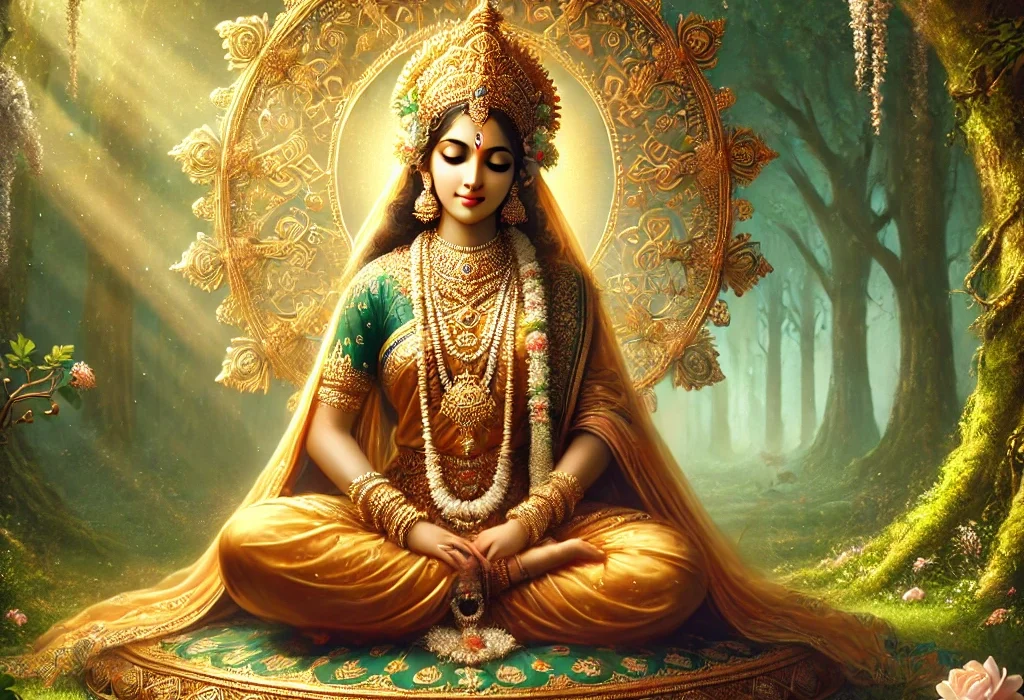Sita, Known as the epitome of devotion, virtue, and sacrifice, Sita is more than just a character in the Ramayana—she is a symbol of ideal womanhood and an embodiment of divine grace. To understand her significance is to delve into the heart of Hindu philosophy, exploring themes of love, loyalty, and resilience.
The Divine Birth of Sita
Sita’s story begins with her miraculous birth, a narrative deeply intertwined with the fertility and nurturing qualities of the Earth. According to the Ramayana, King Janaka of Mithila discovered Sita while plowing the fields as part of a sacred fertility ritual. Her name, derived from the Sanskrit word for “furrow,” underscores her connection to the Earth goddess Bhoomi, who is considered her mother. This unique origin story not only sets Sita apart as a divine being but also associates her with agricultural fertility, highlighting her as a goddess of growth and abundance.
Sita and Ram: The Eternal Bond
Sita is most famously known as the wife of Rama, the prince of Ayodhya and an incarnation of Vishnu. Their relationship, often described as the epitome of marital devotion, is central to the Ramayana. Sita’s unwavering faith in Ram is a recurring theme in the epic, reflecting the ideal virtues of loyalty and sacrifice expected in Hindu marital relationships.
When Ram was exiled to the forest for 14 years, Sita chose to accompany him, forsaking the luxuries of palace life. Her decision illustrates her steadfast devotion and readiness to share in her husband’s trials, embodying the Hindu ideal of “dharma”—righteousness and duty.
The Abduction by Ravana
One of the most dramatic episodes in the Ramayana is the abduction of Sita by Ravana, the ten-headed demon king of Lanka. This event sets the stage for a monumental battle between good and evil. Despite being held captive in Ravana’s opulent palace, Sita remains steadfast in her virtue, rejecting his advances and staying true to her husband.
Sita’s resilience during her captivity is a testament to her inner strength and unwavering moral compass. It also highlights her role as a symbol of purity and endurance, qualities that continue to inspire millions of devotees.
The Trial by Fire
After her rescue, Sita’s ordeal was far from over. To prove her chastity and purity, she underwent the Agni Pariksha, or trial by fire. Walking through flames unscathed, she demonstrated her unwavering fidelity to Ram. This episode has sparked extensive discussions and interpretations in Hindu philosophy, with some viewing it as a testament to Sita’s divine nature and others critiquing it as an unfair burden placed on women.
Sita’s Later Life and Legacy
Sita’s story concludes with her return to the Earth, her eternal mother, signifying her ultimate liberation and return to divinity. This poignant ending, where she disappears into the ground after asserting her integrity, underscores her connection to the Earth and her transcendence beyond mortal struggles.
Her life, filled with trials and triumphs, serves as a guide for individuals navigating the complexities of duty, love, and morality.
Philosophical Insights from Sita’s Life
The Ramayana is not merely a story but a philosophical text that offers profound insights into human behavior and ideals. Through Sita, it presents the archetype of an ideal wife and woman, balancing virtues of compassion, strength, and devotion.
Sita’s life encourages readers to reflect on questions of personal integrity, the challenges of adhering to one’s principles, and the sacrifices required in fulfilling one’s duties. Her resilience amidst adversity offers a timeless lesson in courage and faith.
Sita’s Relevance in Modern Times
Though Sita’s story originates in ancient times, her values resonate powerfully in the modern era. She is seen as a feminist icon by some, representing the strength to endure and overcome societal pressures. Her devotion, paired with her moments of assertion, provides a nuanced perspective on womanhood that transcends cultural and temporal boundaries.
In today’s world, where questions of morality, loyalty, and personal integrity are increasingly complex, Sita’s life serves as a moral compass. Her unwavering commitment to her principles inspires people to stay true to their values, even in challenging circumstances.
Why Sita Matters
For those exploring Hindu philosophy or seeking spiritual guidance, Sita represents the perfect harmony of human and divine qualities. Her story, deeply rooted in the Ramayana, is a treasure trove of lessons on virtue, resilience, and love.
In temples and homes across India and the world, Sita continues to be worshipped alongside Ram, symbolizing the eternal bond of love and duty. Her legacy is celebrated in festivals, rituals, and art, keeping her memory alive for generations.
Conclusion
Sita’s tale is more than just an ancient story; it is a timeless narrative that speaks to the deepest human emotions and aspirations. As the embodiment of purity, strength, and devotion, she remains an enduring figure in Hinduism, inspiring countless devotees with her life and values.
To understand Sita is to understand the essence of the Ramayana and the virtues it seeks to impart. Through her story, we learn that true strength lies in unwavering faith, compassion, and the courage to uphold one’s principles, no matter the circumstances.
Whether you are a devotee, a scholar, or someone seeking inspiration, Sita’s life offers profound lessons that transcend the boundaries of time and culture.
